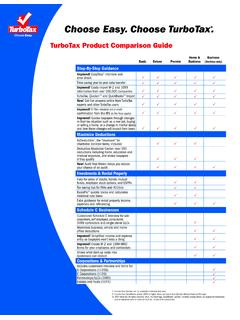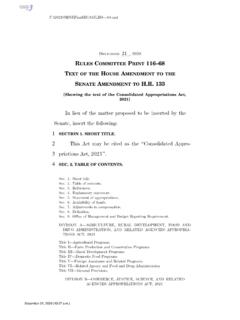Transcription of A comparison of PCE and CPI: Methodological Differences …
1 A comparison of pce and cpi : Methodological Differences in inflation calculation and their implications November 2017 Noah Johnson bureau of labor statistics , 2 Massachusetts Ave NE, Washington, DC 20212 Abstract inflation is a key economic indicator reflecting the health of an economy. Its impact on measuring economic health is amplified by its use as an adjustment to other economic variables, including real GDP and real wage growth. There are a number of components to inflation estimation, and the methodology for each can differ, leading to different inflation estimates. The Consumer Price Index (CPI) and Personal Consumption Expenditures Price Index (PCE) are two inflation metrics that use different methodologies, and therefore produce different estimates.
2 According to the bureau of Economic Analysis (BEA), the Differences can be grouped into four effects: formula, weight, scope, and other. This research evaluates two effects, weight and scope, and discusses their implications . The weight effect is a result of Differences in how consumer expenditure data are sourced. CPI sources data from consumers, while PCE sources from businesses. The scope effect is a result of the different types of expenditures CPI and PCE track. For example, CPI only tracks out-of-pocket consumer medical expenditures, but PCE also tracks expenditures made for consumers, thus including employer contributions. The implications of these Differences are considerable.
3 Many contracts and government programs are tied to inflation , from rental agreements to social security, valued in the trillions of dollars over time. Small Differences in the estimated level of inflation can thus have far reaching impact, as even a tenth of a percent difference translates into billions of dollars. Key Words: Price indexes, Consumer Price Index (CPI), Personal Consumption Expenditure Price Index (PCE), inflation , Consumer Expenditure Survey (CE), Price Change Measurement Any opinions expressed in this paper are those of the author(s) and do not constitute policy of the bureau of labor statistics . 1.
4 Introduction There is a large body of research investigating the difference between the Consumer Price Index (CPI) and the Personal Consumption Expenditure Price Index (PCE). The CPI and the PCE, and their core inflation counterparts, are two primary metrics of inflation . The bureau of labor statistics (BLS) produces the CPI, while the bureau of Economic Analysis (BEA) produces the PCE. CPI and PCE are the primary indicators used by policymakers and academics when evaluating inflation faced by households in the United States. inflation is an important measure of an economy s health; moreover, its importance is amplified because it is used to adjust other economic indicators, thus enabling economists and policymakers to evaluate real changes in economic data rather than nominal ones.
5 The variance between them raises a number of questions. What causes this difference? How and why are they different? Is one better than the other? If so, why produce both, especially in an era of federal budget tightening? Therefore, it is important to understand what each inflation metric offers to users, what their advantages and disadvantages are, what drives their Differences , and why both provide useful, albeit different, insight into the economy. According to the literature, the causes for the difference between CPI and PCE can be attributed to four effects: formula effects, scope effects, weight effects, and other effects.
6 These are the effects that result from the various Methodological Differences in the construction of the two indexes. There are a number of Methodological components involved in constructing inflation indexes. Formulas, weights, and scope are three such components, the impact of each being singled out with the impact of the remaining components combined in the other category. The formula effect is a result of the indexes using different formulas; the CPI uses a Laspeyres-type index formula, while the PCE uses a Fisher Ideal index formula. The scope effect reflects the difference in definitions between what the CPI and the PCE are trying to measure.
7 The CPI considers only the urban population and out-of-pocket expenditures by consumers. The PCE considers both urban and rural populations, and includes all expenditures purchased on behalf of consumers, even if it is by a third party such as a non-profit. The weight effect is the result of sourcing consumer expenditure data which are used to weight the price changes of items from different surveys. Expenditures in the PCE Price Index use the Personal Consumption Expenditures from the National Income and Product Accounts (NIPA) tables, hence the name of the index. These expenditures measure what businesses sell to consumers. CPI expenditures are sourced from the Consumer Expenditure Survey (CE), which is a combination of two surveys of what consumers purchase from businesses.
8 The PCE and CE surveys not only have different respondents and different goals, they have different survey methodologies. The scope and formula Differences have ancillary weight effects in addition to the survey-derived weight effect. Finally, there are other Differences that result from a combination of factors, such as the varying price data. This research looks into which items in the CPI market basket drive the weight and Differences . By building on research done by Caitlin Blair, this analysis uses the expenditures from the PCE to create a PCE-weighted CPI index. Doing this brings the two indexes closer together and isolates the impact of the survey source for expenditure data.
9 Going further, the PCE-weighted CPI expenditure data are also adjusted to reflect scope Differences in order to see the impact of the scope and weight effect combined, thereby accounting for scope-related weight effects. Finally, the indexes that were created are used to deflate nominal economic data. The importance of an accurate inflation measurement can be seen in its impact on economic data, in this case Social Security adjustments. The paper ends with an overview of future research that could be conducted and a discussion of unresolved issues. 2. Literature Review They are constructed differently, leading to Differences in their measurement of inflation .
10 Constructing a consumer price index to measure inflation requires combining two primary components, weights and prices, using an index formula. Before that, however, one should decide how to define inflation in other words, the scope. Is inflation the price increase faced by consumers, urban consumers, or working consumers? Do price increases of goods and services consumers do not purchase themselves warrant inclusion? Once the scope has been determined, one needs to pick a market basket that reflects the goods and services consumers purchase. The change in prices for the goods in the market basket are then tracked. The price changes are subsequently weighted to reflect various items proportional impact on consumers budgets.














